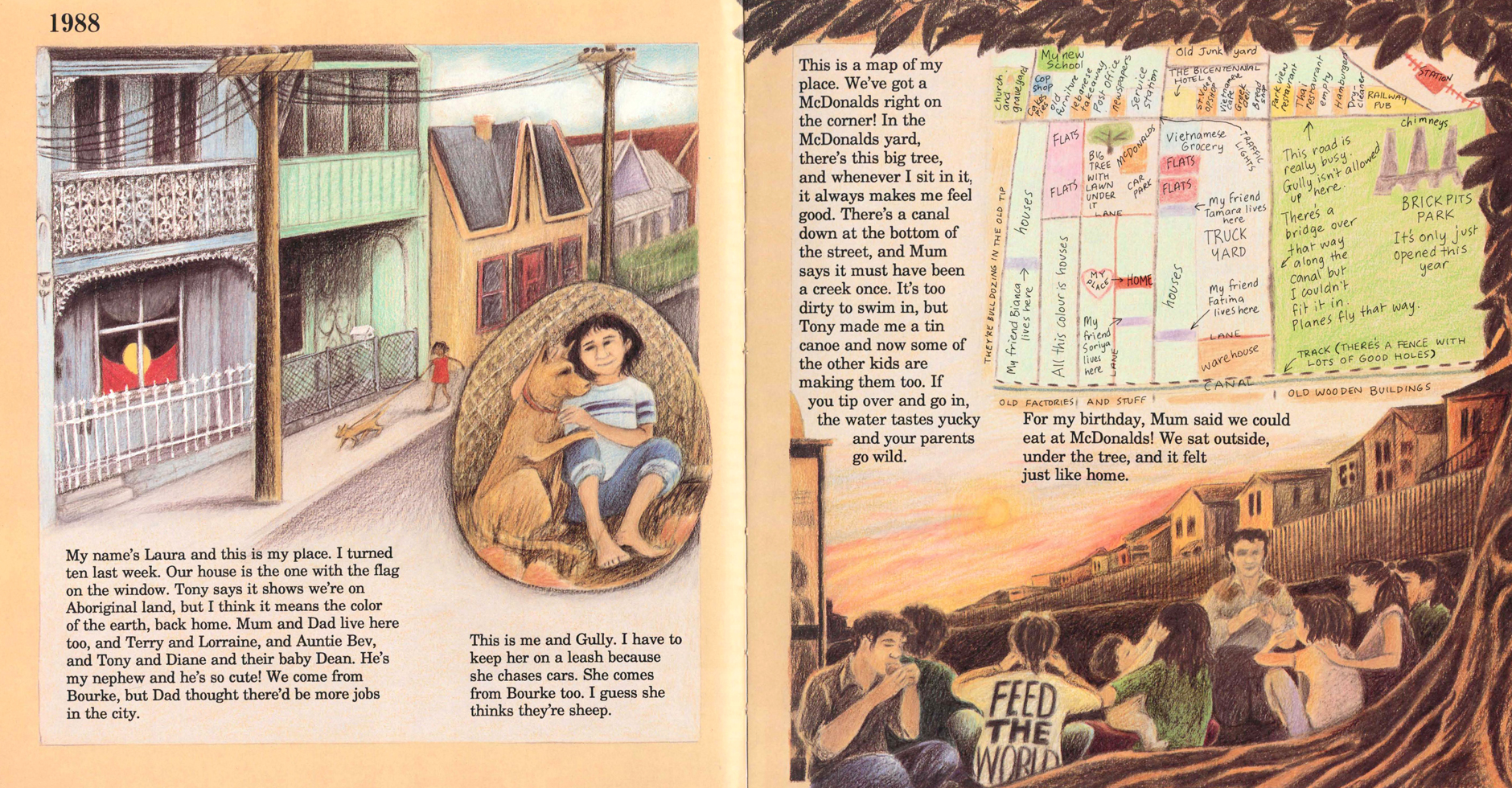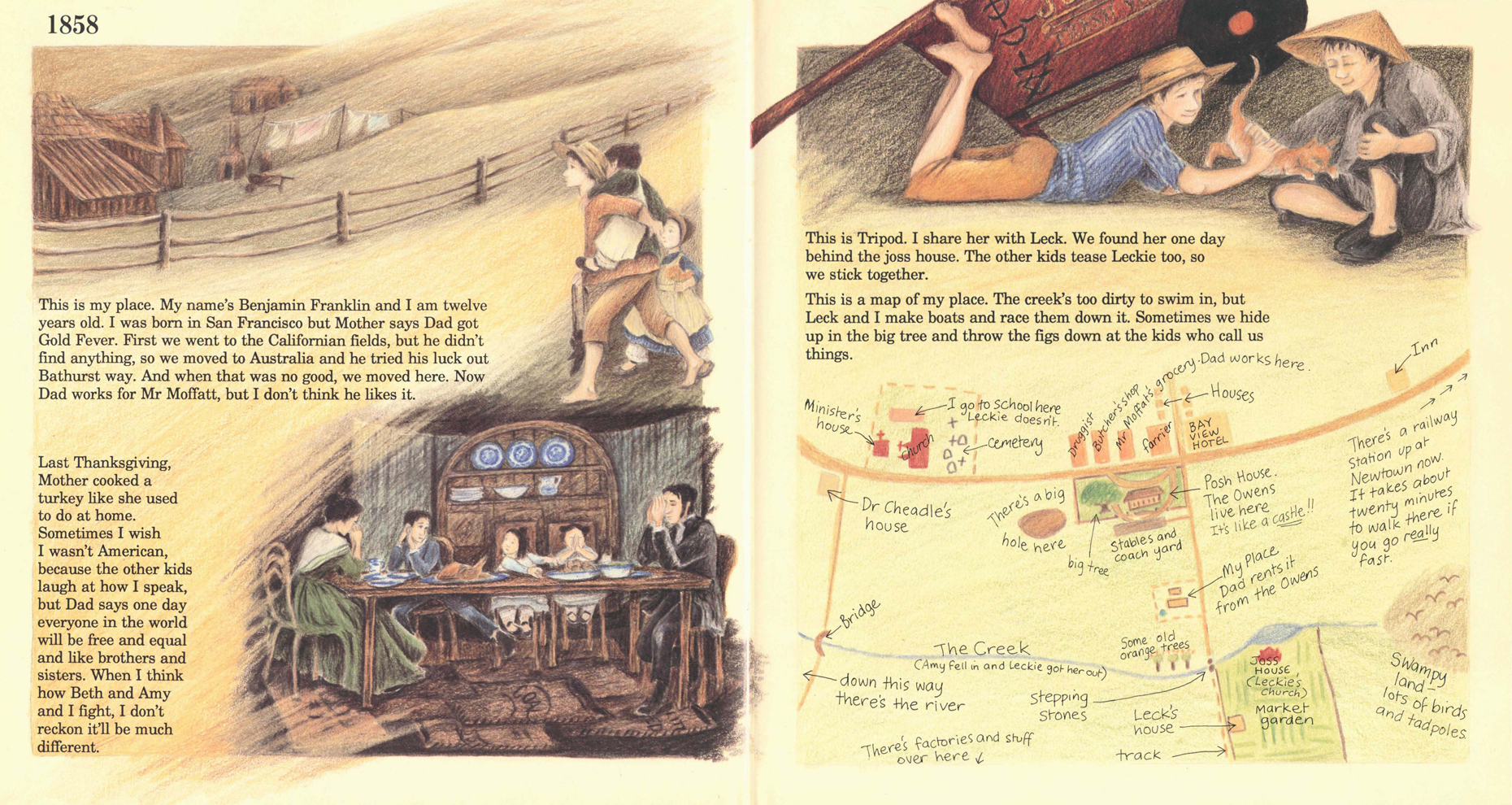My Place
Not yet having any kids of my own, I’m not usually one to pay much attention to children’s books (although Richard Scarry’s Busy Busy World will always be a source of fond nostalgia for me).
But Bill Cronon recently introduced me to a unique and frankly just plain wonderful example of the genre. My Place, written by two Australians—historian Nadia Wheatley and illustrator Donna Rawlins—beautifully interweaves so many threads from our relationship to both history and the environment that it has something for almost everyone, regardless of how old you are.
Here’s the back blurb:
WARNING:
THIS BOOK IS A TIME MACHINE!
It flips you back into the past, where you’ll meet other girls and boys who care about the same things as you do. Once you come out the other end, you’ll see that everyone is part of History, and every place has a story as old as the earth.
Pretty ambitious, huh? Yet it actually manages to follow through in a sweet, deeply thoughtful way.
Here’s how it works. The book begins in 1988 with ten-year-old Laura introducing her home (“my place”) and family. Opposite, she presents us with a hand-drawn map of her place and narrates a few important features in the neighborhood. Be sure to click the images for full-size versions (they’re quite large—find the “close” button in the image’s bottom-right corner).

Notice the “big tree” and a creek-turned-canal: they provide some key geographical anchors in the book alongside the little home marked “my place.”
Turn the page and we find “nearly seven” Mike in 1978 introducing his place, but with a few notable changes. It’s ten years before Laura and her family have moved in and Mike’s multi-generational Greek family live in a slightly different neighborhood (with a slightly different map) than the one we encountered on the previous page. The big tree and the canal are still there, though, and it pays to flip back and forth between Laura and Mike’s maps to see what might have changed in the decade between 1978 and 1988.
With each leaf, we move another decade back in time, finding the same place presented across a similar two-page spread. And each successive move into the past brings us a new narrator who subtly gestures at the various changes taking place over time. Here’s the spread for 1858, 130 years before Laura’s family moves in:

Our new narrator is twelve-year-old Benjamin Franklin. Born in San Francisco, he came to Australia after his father failed to strike gold in California. Other kids in town tease Benjamin for his American accent, so he spends most of his time with a Chinese boy named Leck and their shared cat, Tripod. Over a century older than Mike and Laura’s maps, Benjamin’s guide to his place illustrates a remarkably different landscape. The big tree sits in the yard of a “posh house” belonging to the wealthy Owens family (the Franklin family rents from them). What will be a canal in the late 20th century is a creek, although a dirty one. And there are hardly any other buildings on the map at this point—the urban neighborhood of the 1970s and 1980s is almost entirely undeveloped.
Originally conceived as part of the Australian bicentennial, My Place continues like this all the way back to 1788 when we’re introduced to a young Aboriginal girl named Barangaroo. “I belong to this place,” she says. It’s a nice gesture at the fact that the idea of land as private property (“my place”) doesn’t yet exist in her world. In fact, this final move back in time is a lovely bookend to an observation Laura makes all the way in the future of 1988: “Our house is the one with the flag on the window. Tony says it shows we’re on Aboriginal land….”
It’s at this point that the book’s soft touch becomes apparent. Doing a wonderful job of showing instead of telling, My Place incorporates some quite sophisticated observations about Australian culture, history, and environmental change without being overly didactic. We see evidence of the country’s many, diverse waves of immigration and settlement, not to mention some darker elements of the Australian past, from colonialism to anti-immigrant xenophobia. Wars and the global depression of the 1930s make appearances alongside references to industrialization, environmental pollution, and even political-economy. Benjamin Franklin’s father in 1858, for example, offers a nod to Karl Marx: “one day everyone in the world will be free and equal and like brothers and sisters.” Even people’s diverse and changing relationships with animals are present as the various children narrating My Place introduce a wide variety of pets and working animals.
And again, it manages to do all this without hitting you (or your kid) over the head. Like the best kind of art or entertainment, you can keep coming back to My Place only to discover ideas you hadn’t quite noticed the first time. Children almost always outgrow their favorite books, but My Place is the sort of thing that would grow with them. And it’s clearly a perfect book for teaching kids (hell, people of any age) about history, geography, and the environment. In fact, Wheatley eventually put together an Australian educational television series and accompanying website based on My Place. Both are very much worth checking out, if only to see an example of the really cool multimedia work that can come out of a book.
For such a humble little thing, My Place manages to be a remarkable, truly unique piece of storytelling full of beautifully subtle insights. It’s out of print in the United States, but you can still pick up copies from bookdealers selling through Amazon. Or you can grab a new copy from the United Kingdom.

5 Comments
Join the discussion and tell us your opinion.
Wow! You’ve convinced me–just bought a copy.
That’s great, AZ! Looking forward to hearing what you think of it.
My Place sounds fantastic! Can’t wait to read it. One of my favorite books to read to Everett is “Let’s Go! The story of getting from there to here,” which also fits this genre. It is an environmental history of transportation in North America (for 7 year olds). Thanks for the write-up.
Heh. Awesome. I’ll check it out for my dissertation bibliography 😉 Thanks for reading!
[…] blog about watery landscapes. Some detours into neurobiology, epigenetics, animal friendships, and children’s literature aside, I usually manage to stay focused on the soggier entanglements of society and […]